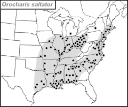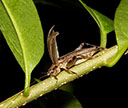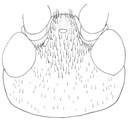|
Song at 25°C:
|
Loud, clear chirp repeated at irregular, 1.5-3 sec. intervals. Difficult to localize. Chirps have 10––18 pulses at 55 p/s. Carrier frequencies decline by more than 1 kHz at temperatures below 25°C.
|
|
Identification:
|
Length 15–20 mm. The only species of its genus in most of its range. Where it overlaps with the false jumping bush cricket (O. luteolira), it can be identified most reliably by song and season. Stridulatory file has 70–85 teeth.
|
|
Similar species:
|
False jumping bush cricket (O. luteolira)—no distinguishing morphological features; chirps shorter (0.15 sec.) with fewer pulses (4-9) and faster pulse rate (71/sec.). Where O. luteolira and O. saltator occur together, O. luteolira is most abundant in well-drained, open woodland and has two generations each year with adults numerous Apr.–June and mid-Aug.–Oct.
|
|
Habitat:
|
Broadleaved trees; occasionally in herbaceous undergrowth, shrubs, and pine trees.
|
|
Season:
|
Aug.–Oct. (Ind.), July–Dec. (La.) Throughout its distribution the jumping bush cricket apparently has but one generation a year and overwinters as eggs.
|
|
More information:
|
Subfamily Eneopterinae, genus Orocharis.
|
|
References:
|
Funk 1989, Maier 2017.
|
|
Nomenclature:
|
OSF (Orthoptera Species File Online).
|
















